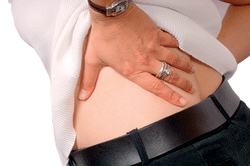 History and Presenting Symptoms
History and Presenting Symptoms
A 44-year-old female reports occasional episodes of pain in her lower back, primarily on the left. Her low back pain seems to be randomly intermittent, but is worse when she’s been on her feet for a while. Currently it takes about one hour of walking or standing for her to notice tension building in her low back. She localizes her pain to the left lower back and upper pelvis; she has not noticed any pain extending into her leg. On a 100mm Visual Analog Scale, she rates her low back pain at about 20mm, with an occasional 50mm. She takes non-prescription anti-inflammatory tablets when the pain in her lower back interferes with her daily or work activities. Now that her three children are grown, she works about 30 hours a week for a local non-profit organization, primarily at a desk.
Exam Findings
Vitals. This is a large woman who weighs 171 lbs. which, at 5’11’’, results in a BMI of 24; she is not overweight, but is close. She is a non-smoker, drinks beer moderately, and her blood pressure and pulse rate are within normal ranges.
Posture and gait. Standing postural evaluation finds a lower iliac crest on the right, and a low right greater trochanter. The left shoulder is somewhat lower than the right, with no history of fracture or surgery. Her knees are well aligned and her lower extremities are symmetrical, with no significant calcaneal eversion, foot flare, or low medial arch. Inspection of her shoes finds minor wearing at the lateral aspect of both heels.
Chiropractic evaluation. Motion palpation identifies several limitations in spinal motion: the left SI joint, the lumbosacral junction, L2/3, and at the cervicothoracic junction. Except for the left SI joint and the left piriformis muscle, palpation elicits no significant tenderness in these regions, and all active spinal ranges of motion are full and pain free. Hip ranges of motion are also full and pain free. All provocative orthopedic and neurological tests for nerve root impingement and/or disc involvement are negative.
Imaging
A-P and lateral lumbopelvic X-rays in the upright, standing position are taken with the patient weight-bearing, heels aligned directly under the femur heads, and both knees extended. A substantial discrepancy in femur head heights is noted, with a measured difference of 8mm (right side lower). A moderate lumbar curvature (6°) is noted, convex to the right side, and both the sacral base and the iliac crest are lower on the right side. The sacral base angle and measured lumbar lordosis are within normal limits.
Clinical Impression
Multiple lumbopelvic fixations, with anatomical leg length discrepancy (right short leg) and associated pelvic tilt and lumbar curvature.
Treatment Plan
 Adjustments. Specific adjustments for the lumbosacral and sacroiliac joints were provided, and other regions received adjustment as needed. Side-posture adjustments were well tolerated and resulted in very good articular releases.
Adjustments. Specific adjustments for the lumbosacral and sacroiliac joints were provided, and other regions received adjustment as needed. Side-posture adjustments were well tolerated and resulted in very good articular releases.
Support. Flexible, custom-made stabilizing orthotics were fitted, based on foot imaging in mid-stance (weightbearing). A 6mm heel lift was permanently built onto the left side. These were introduced after the first week of regular adjustments. She reported no difficulty in adapting to the orthotics or the heel lift.
Rehabilitation. She was instructed in a daily core strengthening program (the “easy eight” exercises) at home, using elastic exercise tubing. The focus was on activation of the patient’s transverse abdominis musculature, to improve spinal-pelvic stability.
Response to Care
This patient responded well to her adjustments, and adapted well to her orthotics with the heel lift. After 6 weeks of adjustments (8 visits) and daily home exercises, she was released to a self-directed home stretching program.
Discussion
This patient had developed a chronic lumbopelvic fixation, caused by her anatomical discrepancy in leg length. By necessity, her chiropractic treatment plan included orthotics with a permanent heel lift on the right side to support her strained lower extremities. I have found that, when a heel lift is needed, it is tolerated best when the entire foot and both lower extremities are supported with custom-made orthotics.
